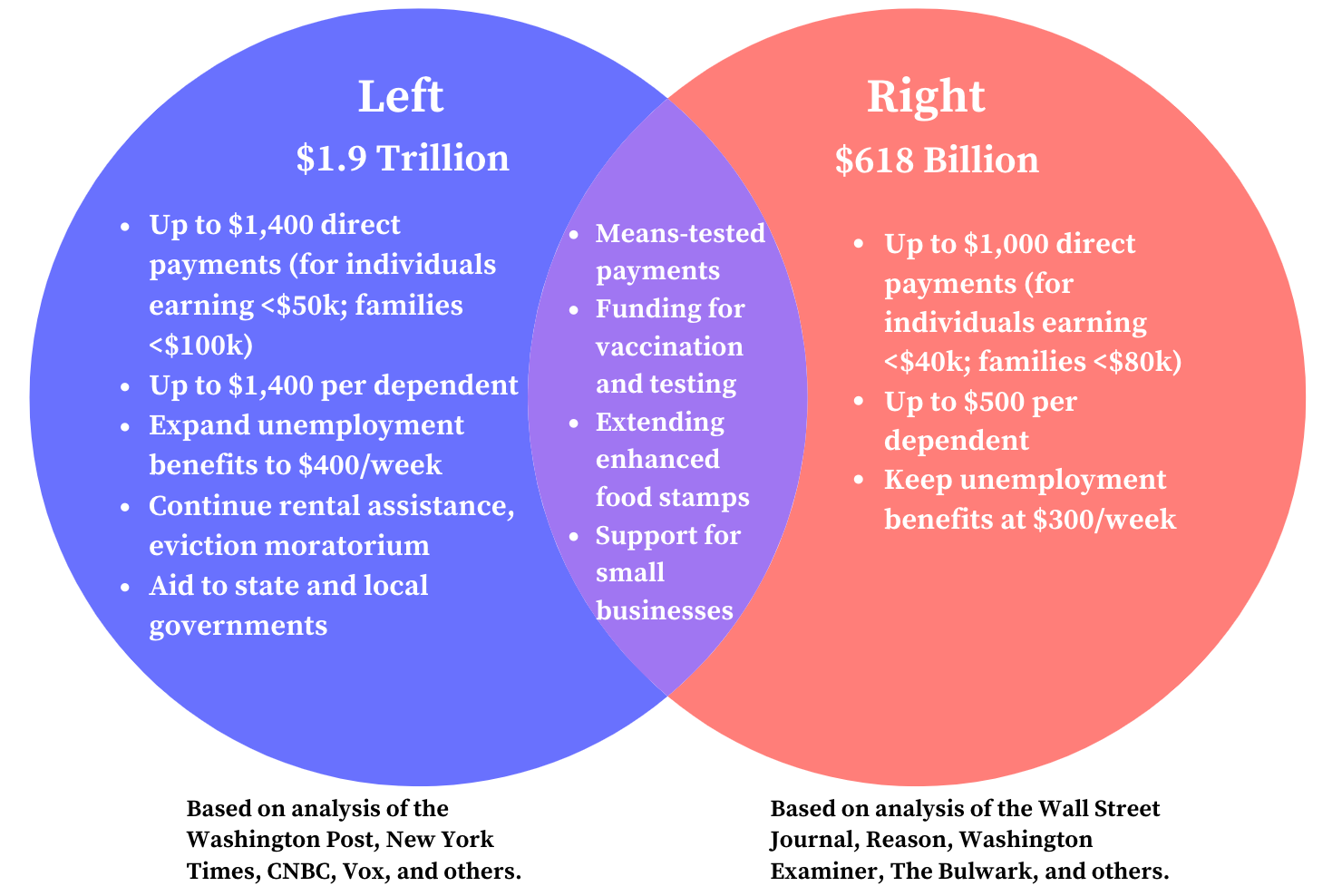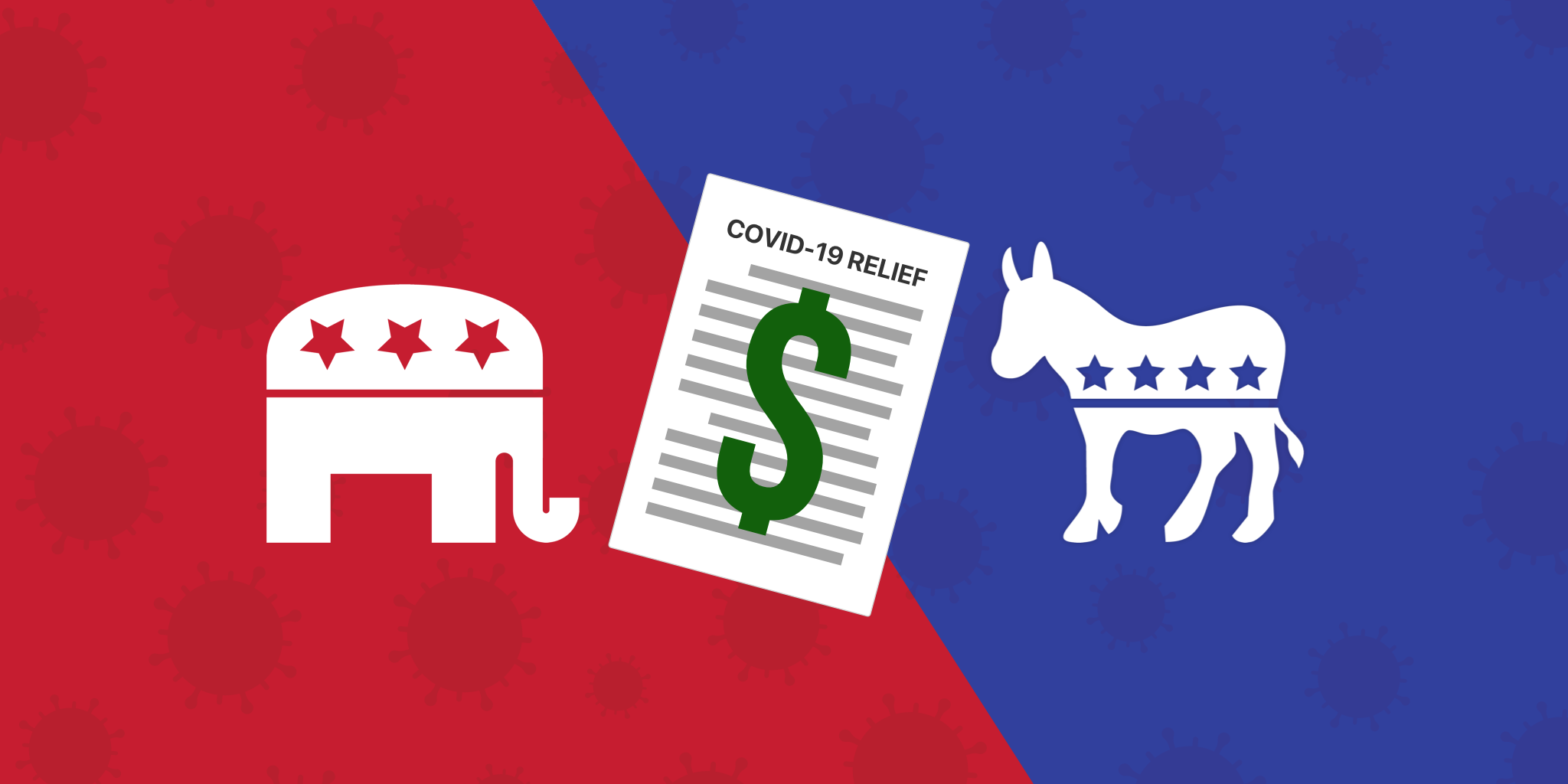At the center of the ongoing tug-of-war in Congress over the next round of economic recovery efforts are competing perceptions about whether and how Americans need economic support. The country has deep economic divergences, with record levels of personal savings and a booming stock market, but also millions facing prolonged unemployment or eviction. Should we be worried about stimulus measures that do too much or too little? What kind of stimulus will be the most effective for families across the country and the economy overall?
This week, The Factual used 43 articles from 27 sources across the political spectrum to examine the economic costs of Covid-19, reasons for economic optimism, and how these factors are interplaying to influence economic recovery efforts.
The Uneven Economic Costs of Covid-19
The macro-level numbers show, for example, that the U.S. economy shrunk by 3.5% in 2020 and that the pandemic “effectively erased all the economic growth of 2018 and 2019.” While certainly sizable, this damage is also deceivingly uneven. Higher-earning jobs, especially in tech-enabled fields, are largely untouched. For these individuals, and indeed many high- and middle-income Americans, the true economic costs of Covid-19 may go relatively unseen.
Meanwhile, lower-income individuals and specific industries like travel and food are in dire straights. December saw nearly 500,000 layoffs in leisure and hospitality, and according to the Washington Post, “some 110,000 restaurants and bars — more than 1 in 6 across the country — have gone under since March.”
Please check your email for instructions to ensure that the newsletter arrives in your inbox tomorrow.
Women and Black and Latino populations in particular have suffered disproportionately, partially due to their high representation in such industries and partially due to other factors that magnify the economic hardships of Covid-19. For example, women are more likely to leave work to assist with childcare, partially due to social and cultural norms, while minority populations are typically underserved in healthcare and financial services and less likely to own their own homes or have substantial savings.
In this way, the pandemic has both caused irreparable damage to some businesses and reversed progress on important metrics like income equality and workplace participation. The follow-on effects of these losses, on specific industries, groups, and regions, may far surpass the obvious immediate financial costs. Businesses that close in riskier industries may not simply reopen, and barriers to employment to certain groups may make finding re-employment at a similar level more difficult.
On the left, notice the partial recovery, then decline, of employment numbers for low-wage workers. On the right, note that nearly everyone with a bachelor’s degree or higher who lost a job in the spring had regained employment by September. Source: Wall Street Journal
All of this combines into what many are terming a “k-shaped” recovery, where a portion of society quickly rebounds from early pandemic losses while other portion lags behind, contrasting with recent economic crises that have seen a “v-shaped” or “u-shaped” recovery. Large companies, already typically armed with large cash reserves, have found it far easier to access relief funds and get support from the government, but small businesses have struggled to access meager resources in a timely manner, “like travel/hospitality where 62% expect to permanently close, 61% of gyms and fitness centers, and 60% beauty salons.” This dynamic was powerfully captured by ProPublica: well-connected, larger firms are profiting, often from government dollars, all while making cuts to lower-wage workers. Meanwhile, the small businesses at the bottom of the same big-city highrises, such as the corner convenience store, face existential financial difficulties.
Reasons for Economic Optimism
The economic picture is not uniformly gloomy, however. For starters, recovery from Covid-19’s economic crisis seems likely to occur far more quickly than for past crises like the 2008 Global Financial Crisis or the Great Depression. Partially this is because the current crisis is not a banking crisis, meaning money will be freely available to spend as soon as worry about the virus subsides, and partially it relates to the government’s preparedness to leverage fiscal and monetary tools to benefit a rapid recovery. That doesn’t mean the U.S. government’s response efforts have gone perfectly — there are many examples of fraudulent use of Covid relief funds and small businesses struggling to access enough assistance to stay open — but at least major fiscal and monetary measures are enabling, rather than deterring, economic recovery, as they did in the 1930s. Indeed, these expenditures rapidly outpaced what governments spent on the Global Financial Crisis.
Note: These figures are as of June 11, 2020, and response measures have grown considerably since then.
Source: McKinsey & Company
These expenditures have combined with the unique characteristics of the pandemic to lead to record levels of personal savings, in the U.S. and around the world. Particularly for middle- and high-income households, earnings have been relatively stable but expenditures decreased as lockdowns discouraged consumer spending on retail, travel, and other services. This leaves many speculating that the economy is primed for a more forceful revival once vaccination levels reach sufficient levels to significantly decrease risk. Warier perspectives consider that the wealth accruing to the upper echelons of society — like the nearly $4 trillion that has accrued to billionaires worldwide during the pandemic — has brought little benefit to those fighting unemployment, hunger, and homelessness right now. Either way, spending may rapidly increase and help alleviate pressure on low-income workers.
Source: Reuters
There are also smaller economic bright spots to be considered throughout the country. Some industries have boomed during the pandemic and may help pick up some slack. Americans opened new businesses at “staggering” rates, some out of necessity and others surely inspired by too much time at home. In the third quarter of 2020, Americans submitted 1,500,000 new business applications, almost double the typical 800,000 per quarter, and these are from diverse locales across the country, with the Midwest leading the way. And a shift to working from home may revolutionize job culture long after the pandemic subsides, with attendant benefits for workers who can spend more time with family and less time commuting. Only time will tell to what degree these changes will remain after the virus recedes.
Please check your email for instructions to ensure that the newsletter arrives in your inbox tomorrow.
Striking a Balance Between Doing Too Much and Too Little
The government has much to do to enable a “soft-landing” for those disproportionately impacted by Covid-19’s economic effects while keeping in mind that other portions of the country are already primed to enjoy and further enable a rapid economic recovery once it becomes safe to do so. The debate now focuses on how lawmakers can target and right-size economic relief efforts so that they directly and adequately assist the people who need it most while avoiding needless spending and worries about negative side effects.

The Biden administration’s proposed economic response package is generous, reflecting a desire (not to mention campaign promises) to address the concerns of the millions of Americans who have arguably received insufficient assistance during these difficult months. Direct payments would provide up to $1,400 and include up to another $1,400 per dependent. The latest proposal would see full payments go to individuals making $50,000 or less and married couples making $100,000 or less, a similar to the first stimulus rounds despite Biden’s original proposal being more inclusive. Unemployment benefits would be increased to $400 a week, $100 more than the current level, and extended through September. Other major elements include continued rent assistance, an extended eviction moratorium, and considerable aid to state and local governments hit hard by the pandemic.
A group of Republican senators has returned with a more targeted version that would reduce eligibility to lower income brackets and offer up to $1,000 per person, along with $500 per dependent. Full payments would be restricted to those earning less than $40,000 and married couples earning less than $80,000. The plan keeps unemployment benefits at $300 a week and extends them until June. It stands out from Biden’s plan in that it does not pursue action on rent assistance, an eviction moratorium, or financial aid to struggling local-level governments. However, the plan does come in at a significantly lighter $618 billion, just a third of Biden’s $1.9 trillion plan, an added benefit for those who are particularly concerned about the federal deficit.
On some measures, the plans actually have a significant amount of overlap. For example, both direct sizable funding toward vaccination and testing programs, extend enhanced food stamp assistance, and offer various measures of support for childcare providers. And overarchingly, both proposals attempt to align with Americans’ support for direct payments and for means-testing such aid.
Critics of Biden’s plan on the left and right are eager to point out that it may give too much money to people who don’t need it, and not enough to the people that do. As a result, Biden has opened the door to negotiation. Meanwhile, left-leaning critics highlight that the Republican proposal strips out critical elements to help the worst-impacted, like unemployment benefits, and right-leaning critics also offer that doing too little would be worse than doing too much. These disagreements will continue, but “virtually no one disputes the need for something.”
Appendix
This appendix lists all 36 articles from 25 sources across the political spectrum used to inform the findings of this article and how the articles scored according to The Factual’s credibility algorithm. To learn more, read our How It Works page.

